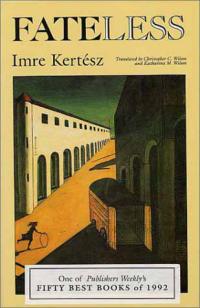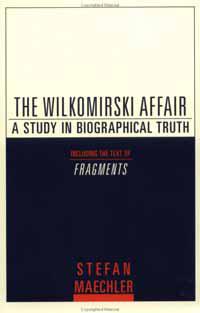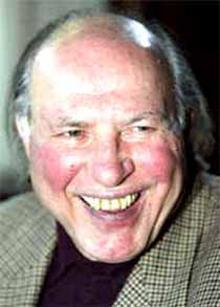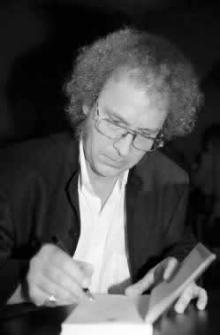The New Face of the “Holocaust”
As is generally known, crematoria are designed in such a way that even during intense activity neither smoke nor flames escape from their chimneys, and they also do not produce objectionable smells. Nevertheless, in a book, for which the “Holocaust survivor” Imre Kertész received the Nobel prize for literature, one reads of smoking crematorium chimneys in German concentration camps, from which allegedly a “real firework of flames and sparks” escapes and which spread an unpleasant smell. Kertész also reports untruthfully that poisonous gas came out of shower heads onto the heads of the victims, although such an application with the allegedly used gas (Zyklon B) is technically not possible. And on top of all that it turns out that Kertész possibly plagiarized one of his scenes from a famous “Holocaust” liar. What is the Nobel prize for literature worth when it is awarded to confirmed liars exactly for their cock-and-bull stories? And what about a civilization that celebrates such?
On December 10, 2002, the one hundred sixth anniversary of the day Alfred Nobel died, the Hungarian-Jewish author Imre Kertész received the Nobel prize for Literature for his work entitled Fateless.[1] As in the novel Kaddish for a Child Not Born and the anthology A Moment of Silence while the Execution Commando Recharges, the author elaborates about his experiences in the concentration camps Auschwitz and Buchenwald. Kertész depicts his familiar milieu in Budapest on the occasion of his father's conscription to work duty, his arrest in the summer of 1944 by the Hungarian police, his deportation to the concentration camp Auschwitz, and after only four days, further to the camp Buchenwald. The fifteen year old describes his time as a forced laborer in the outstation Zeitz and in the sick bay of the camp. He finishes with a philosophical dialogue after his return to Budapest.
Although Kertész's fate has many parallels with the Nobel peace prize laureate Elie Wiesel's, his literary elaboration is notably different. While Wiesel's work Night groans of pathos, Kertész recounts from the perspective of an astounding child, apparently without judgment and without bitterness. Almost none of the narratives of the harassments and molestations of the camp conclude without adding “this I could understand” or “yes, of course.” The calculated docility finally culminates in the following sentence at the end of the book:[2]
“Yes, of this, the bliss in the concentration camps, I should tell you, when you ask me the next time.”
The naivety of his narrative style let the author appear free of exaggerations, but behind the mask of innocence Kertész spreads all the familiar horror fantasies of the “Holocaust”: the gas chambers, the smoke- and fire-belching chimneys of the crematoria, the selections and murder of those unfit to work, and the planned genocide of the so-called extermination camps.
Kertész's description of the murder of people with gas is vague. Only at the end of his novel does he focus on this crime. However, right from the start he includes narrative elements that belong obviously to the forensic context of the “gas chambers”. He frequently mentions an unspecified “chemical”, which was allegedly contained in the water and air of the camp Auschwitz:[3]
“A sign next to it warned with red letters: 'No Drinking Water' – but obviously this could not hold us back at that moment. The soldier was quite patient, and I can say this, that no water had tasted that good to me for quite some time, even though I had a peculiar, sharp and disgusting chemical aftertaste in my mouth.”
A little later Kertész returns to this “chemical” that allegedly escapes from the chimneys of the crematoria:[4]
“At this time we became aware of the smell, quite seriously now. It would be difficult to describe it precisely: sweetish and somehow gluey, also with the now known chemical, so that I was almost a little afraid the bread that I mentioned would come up again. It was not difficult for us to determine the source: One chimney was the culprit, on the left hand side in the direction of the highway, but much further away… Actually – as I gradually realized, without knowing how – the chimney was not really a leather factory, but a 'crematorium', i.e. the chimney of a cremation oven, as the term had been described to me. Then I looked at it a little closer: It was a short, rectangular chimney with a wide opening; the top had a chopped-off appearance. Except for a vague unease – and, of course, the smell, in which we were trapped, as if in mud or a swamp – I did not feel much. But then, to our surprise, we could see another in the distance, then another, and then at the edge of the illuminated sky still another chimney from which smoke was escaping as from ours… and maybe those, from which the distant smoke wafts rose behind a puny forest, aroused slow suspicion, and seemed to justify the question, whether the epidemic was of such an extent, that there were so many deaths.”
The word “Krematorium” is printed in the text in italics and with quotation marks, probably to suggest to the reader that these buildings were not cremation installations but “gas chambers.”

Wiesel did without the smell of chemicals in his description of the “smoking” crematorium chimneys:[5]
“He only asked us: 'In three days I will not live anymore… say Kaddish for me.' We promised: Should there be chimney smoke in three days, we would think of him. We would call up ten of us and hold a special memorial.”
The “fire belching” chimneys of the crematoria are a fixed component of the “Holocaust” literature. Writes Kertész:[6]
“And then I also saw for the first time – because the night still found us in the same location – the color of the night and one of its sights: the Bengali fire, a true fire work of flames and sparks over the left side of the sky. Around me many whispered, murmured and repeated: 'The crematoriums!' but, if one wants to say it, somehow with the sense of marvel one has for a phenomenon of nature.”
Wiesel also described the “flaming chimneys” of the crematoria with similar emphasis:[7]
“Suddenly we heard terrible screaming: 'Jews, look! Look at the fire! The flames, just look!' The train stopped and this time we saw the flames that belched into the deep night from a tall chimney. Mrs. Schächter became silent by herself. Silent, apathetic, absently she sat again in her little corner. We looked at the flames in the night. A repugnant smell was in the air.”
The mass murder in the “gas chambers” is at first a rumor with Kertész. He works skillfully with the instruments of hearsay and the incredulity of a child, which moves the horror into the unimaginable:[8]
“There, on the other side, are burning at this moment our travel companions from the railroad, all of whom wanted to go with us in the car, and all of whom the doctor found unfit because of old age or other reasons, like the children and the mothers and the mothers-to-be, where it was already obvious. They also went from the railroad station to the bath house. They also were informed about the coat hooks, the numbers, the procedure in the bath, exactly like us. Hair dressers were there also – as was maintained – and also soap was handed to them. And then they were also led into the bathroom, where, as I heard, were also such pipes and shower heads: except that not water but gas was discharged on them. All this I did not learn at one time, but rather gradually, always with new details, of which some were doubted and others confirmed, yes, even supplemented with additional information. In the meantime – I heard – they were quite friendly to them, they were affectionately cared for, the children sang and played ball, and the place where they were gassed was a beautiful location between lawns, trees and flower gardens: therefore I had finally the impression that it was some kind of a practical joke, something like a student trick.”

Exposure of a Fraud[11]
Kertész appears to have been aware of the scarce evidence of the “gas chamber” already during the thirteen years' work of his novel. In the last chapter is the following dialogue between the homecomer and a doubting Hungarian:[9]
“He was curious to know – about which I had to smile -whether I saw the gas chambers. I said: 'Then we would not now be talking to each other.' 'Certainly', he said, but were there really gas chambers, and I said, but yes, among others there were also gas chambers, of course, and it all depended on what the practice was in the particular camp. For example in Auschwitz their existence was certain. But I, on the other hand – I said – came from Buchenwald. 'From where?' he asked, and I had to repeat: 'From Buchenwald.' 'So, from Buchenwald', he said, and nodded, and I answered: 'Yes.' Whereupon he said: 'But, a moment, please', and this with a rigid, strict, almost schoolmasterly face. 'Therefore you, Sir', and I don't know why, but somehow I was touched by this serious, if not to say somewhat solemn address, 'were told about gas chambers' and I said again: 'But yes.' 'Therefore you did not', he continued still with this rigid face, to create at the same time order and clarity in these things, 'personally, with your own eyes make sure of this', and I had to admit: 'No.' Where- upon he said: 'Aha', and walked on, rigid, straight, upright and, as it appeared to me, somehow also satisfied, unless I was wrong.”
Neither did Wiesel make concrete statements about the “gas chambers”:[10]
“According to Jewish belief the death of a creature belongs only to him alone. It is better that the gas chambers stay closed from curious eyes. Also the imagination should halt before them. We shall never know what happened behind the steel doors.”
Kertész's concoction does not only show parallels to Elie Wiesel's novels, but also to the notorious, freely invented “autobiography” of Binjamin Wilkomirski.[11] Fragments is similar to Fateless, written from the perspective of a child, in the style of a fragmented evolving into awareness of traumatic horrors. Wilkomirski's book, which first appeared in 1995, includes a scene that is so similar to the sequence of the text of Fateless that it is possibly plagiarized. In the chapter entitled “The Brothers” Wikomirski writes:[12]
“Soldiers were standing around. One stood next to me, and curious, I checked him. 'What kind of funny rifle do you have here?' I asked him. I pulled at an object hanging from his belt. Lightning fast he turned around, lightning fast his arm was raised with that strange object in his fist, and something so burned my face that I thought it had been cut in two. This way I learned what a whip is and I understood: The grey one lied – Majdanek is not a playground.”


Holocaust Liar Imre Kertész
Nobel Prize Winner for Literature in 2002
Holocaust Liar Bruno Doesseker aka Benjamin Wilkomirski – exposed and shunned
It is typical for Kertész not to describe this scene as an act of cruelty, and thus he maintains the illusion of childlike innocence:[13]
“Everyone had a rifle on his side, and that was quite natural, after all they were soldiers, one understands. But as I saw, many also carried a stick in their hand, an ordinary walking cane with a rounded end, and that surprised me some, since they were all men in full possession of their strength and ability to walk. Then, from a closer distance, I could examine this object more accurately. I became suspicious when one man a little further up, with his back half turned towards me, took that thing horizontally behind his hips, holding it at both ends and began to bend it up and down with bored movements. I moved closer to him within the group, closer and closer. And then I saw that the object was not of wood, but of leather, and was not a stick but a whip. That was a strange feeling – but I could not see any sign that it was used… well, there were all the many prisoners around, this I understood.”
In the first Yiddish edition under the title Un di velt hot geshvign Wiesel formulated his urge for revenge: “Early in the morning Jewish boys ran to Weimar to steal clothing and potatoes” and literally: “un tsu fargvaldikn daytshe shikses.” – “and to rape German women.” Kertész stays also vague on this question:[14]
“'You probably saw a lot, my boy, much horror', he thought, and I said nothing. 'Well', he continued. 'The main thing is that it is over and out.' His face lightened, he pointed to the houses we just passed and asked what I felt to be back home again, looking at the town I had left at that time. I said' 'Hate.' He was silent for a while, but then remarked that he unfortunately understands my feelings. Apart from that, 'depending on the circumstances,' he opined, even hatred has its place, its role, 'yes its usefulness,' and he assumes, he added, that we would agree on this, and that he knows well who I hate. I said: 'Everybody.'”
The “Holocaust” is a discursive system that started with propaganda announcements and was established in political show trials, entered into the public consciousness with the help of cinematic concoctions, and has meanwhile become omnipresent by way of the media, education, and cultural establishments. In Kertész's literature the “Holocaust” receives a new face. He does not come full of anger as Elie Wiesel does, but quietly, reserved, courteous, almost humble. But still, they are the same lies, raised now to the rank of world literature.
Notes
First published in Vierteljahreshefte für freie Geschichtsforschung 7(1) (2003), pp. 40-43; translated by Fabian Eschen.
| [1] | Northwestern University Press, Evanston, IL, 1992. The quotes are translated from the German edition of this book: Roman eines Schicksallosen, Rowohlt Verlag, Berlin, 4th ed., 2001. |
| [2] | Roman eines Schicksallosen, p. 287. |
| [3] | Ibid., p. 102. |
| [4] | Ibid., pp. 120 ff. |
| [5] | Elie Wiesel, Die Nacht zu begraben, Elischa, Bechtle Verlag, Munich 1962, p. 88. Engl. edition: Night, Bantam Books, 1982. |
| [6] | I. Kertész, op. cit. (note 1), pp. 130f. |
| [7] | E. Wiesel, Die Nacht, op. cit. (note 5), p. 42. |
| [8] | Kertész, op. cit. (note 1), pp. 124f. |
| [9] | I. Kertész, op. cit. (note 1), pp. 263f. |
| [10] | Elie Wiesel, Alle Flüsse fließen ins Meer. Autobiographie, Hoffmann und Campe, Hamburg 1997, p. 114; Engl.: All Rivers Run to the Sea: Memoirs, Schocken Books, 1996. |
| [11] | See in this regard Stefan Maechler, The Wilkomirski Affair: A Study in Biographical Truth, Schocken Books, New York 2001; cf. also Arthur R. Butz, “Historical Past vs. Political Present,” Journal of Historical Review 19(6) (2000), pp. 12-25, here esp. 18-23; Steven L. Jacobs, “Binjamin Wilkomirski (Fragments) and Donald Watt (Stoker): When the Holocaust Story Is a Lie,” CCAR Journal, Spring 2001, http://ccarnet.org/journal/601sj.html |
| [12] | Binjamin Wilkomirski, Bruchstücke. Aus einer Kindheit 1939-1948, Suhrkamp Taschenbuch Verlag, Baden Baden 1998, p. 37; Engl.: Fragments: Memories of a Wartime Childhood, Schocken Books, 1997. |
| [13] | I. Kertész, op. cit. (note 1), p. 96. |
| [14] | Ibid., p. 270. |
Bibliographic information about this document: The Revisionist 2(3) (2004), pp. 297-300
Other contributors to this document:
- Fabian Eschen: translation
Editor’s comments: First published in German in "Vierteljahreshefte für freie Geschichtsforschung," 7(1) (2003), pp. 40-43
